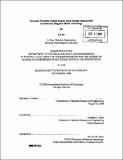Economic potential of high density data storage implemented by patterned magnetic media technology
Author(s)
Du, Lei, M. Eng. Massachusetts Institute of Technology
DownloadFull printable version (21.09Mb)
Other Contributors
Massachusetts Institute of Technology. Dept. of Materials Science and Engineering.
Advisor
Caroline A. Ross.
Terms of use
Metadata
Show full item recordAbstract
Hard drive industry is facing scaling challenge for areal density to be further increased. This is due to the triangular conflictions among thermal stability (superparamagnetic effect), single-to-noise ratio and writability of the recording media. One of the most promising methods to overcome this constraint is the patterned magnetic media technology. Although it is facing many challenges, the large potential gains in density offered by patterned media make it one of the possible milestones on the horizon for future of the disk drives industry. One of the biggest challenges for patterned media is to realize its mass fabrication provided reduced cost per bit. The basic fabrication approach is to use lithography to pattern the magnetic materials on the platter. However, patterned media requires well-ordered nanoarrays with dimensions less than 25 nm, which challenges the state-of-art lithography technologies. This M. Eng. project focuses on evaluations of the technologies and fabrication schemes potential for patterned media from various aspects like technical barriers, cost and intellectual properties. Technologies including E-beam lithography, nanoimprint lithography, templated diblock copolymer self-assembly and self-assembled magnetic nanoparticles are discussed. Cost modeling was done to prove the enormous gain in revenue for the proposed fabrication scheme. It is proposed that the fabrication scheme of templated diblock copolymer for making the master stamp for nanoimprint followed by nanoimprint lithography for mass production has the largest potential for patterned media. However, more R & D is needed for templated self-assembly of diblock copolymer before it is ready for this application. (cont.) E-beam lithography which is a mature technology can also be a choice for making the stamp followed by mass production enabled by nanoimprint lithography, without a significant loss of gain in revenue for ultra-high-density media fabrications. Although the cost of a master stamp fabricated by E-beam is estimated to be 50 times more than for templated self-assembly of diblock copolymer lithography.
Description
Thesis (M. Eng.)--Massachusetts Institute of Technology, Dept. of Materials Science and Engineering, 2008. Includes bibliographical references (leaves 51-55).
Date issued
2008Department
Massachusetts Institute of Technology. Department of Materials Science and EngineeringPublisher
Massachusetts Institute of Technology
Keywords
Materials Science and Engineering.